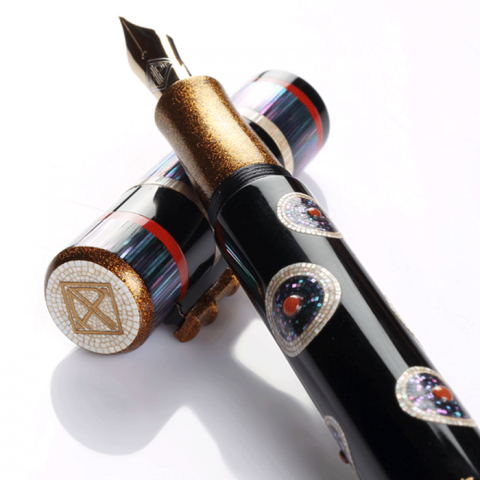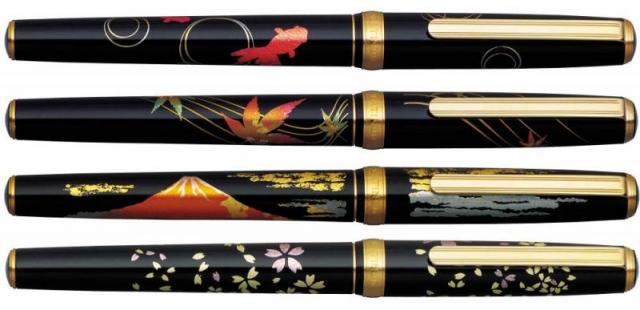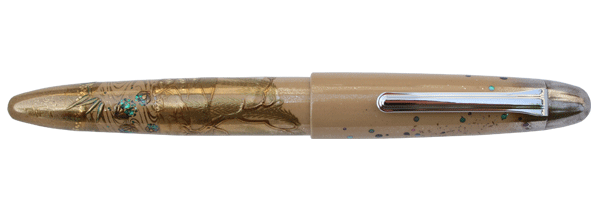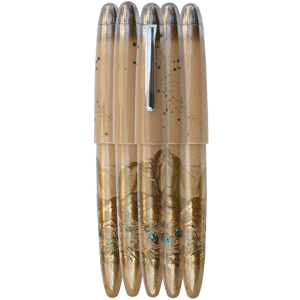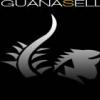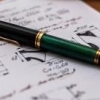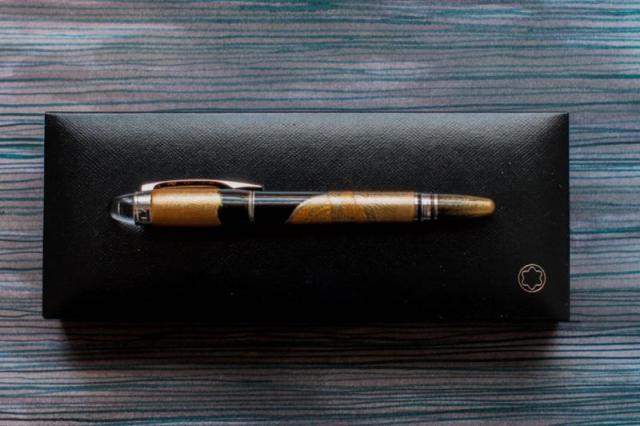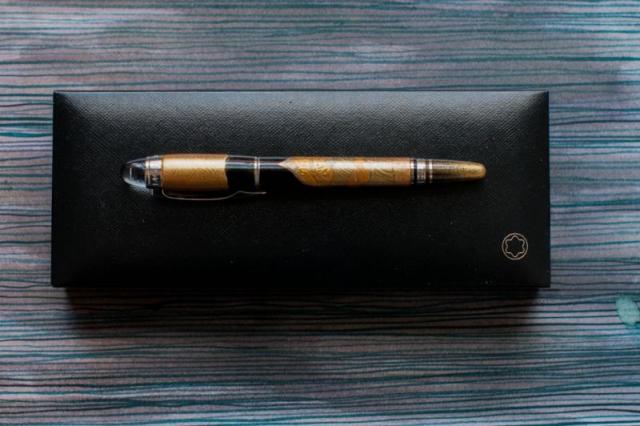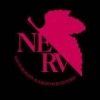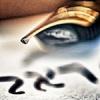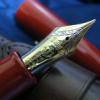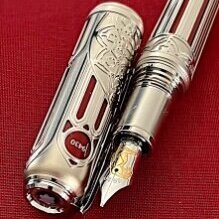Search the Community
Showing results for tags 'maki-e'.
-
Hello to you all, Received some new Nakaya pens and the 'Karasu' is one of them. Yakoh-maki-e on a red tamenuri layer. The pen is a portable cigar. http://www.sakurafountainpengallery.com/en/fpngallery/nakaya-japanse-maki-e
-
For all collectors who love Maki-e pens, the SFPG offers the AP limited edition "The Prayer Wheel". The Prayer Wheel fountain pen was fashioned with consummate artistry and accuracy by the master Maki-e shi artist Kosetsu. The simple yet stunning design features a combination of colours: mainly black with red, white and blue accents. However, in spite of its deceptively simple design there is nothing rudimentary about this exquisite yet practical work of art. You are welcome to check out the complete review on the website : http://www.sakurafountainpengallery.com/en/fpngallery/ap-limited-edition-the-art-of-maki-e Enjoy, Catherine attachment=355529:AP-prayerwheel-soft11.png]
-
- ap limited edition
- the prayer wheel
-
(and 2 more)
Tagged with:
-
Someone is selling this beautiful limited edition pen on eBay for US $178,888.00 In 2010 one was sold by Bonhams for US$ 13,420 inc. premium. Does anyone think they will actually find someone who will overpay this pen for 160.000 dollars? If the answer is yes and there really are idiots like that around I may just take a punt and put one of my P51 on eBay for $4,888.00. I am interested in what you think.
-
I got my first Danitrio a few days ago. I due it to Bry, who offered on FPN no less than 45 different Danitrio’s from his old stock. Among them, there were four Grand Trio’s “Totetsu”. The MRSP of such a FP is 2200 dollars, but Bry offered it at an attractive price. Well, the FP is tagged as “09/50,” that is it was produced in 2009, as a limited edition of 50 pieces. It was a godlike gift for me! You can read a good review of a similar Danitrio urushi Mae West here, so I will not repeat what Doug C already wrote. 1. Appearance & Design (9/10) The FP comes in a traditional Danitrio black lacquered box protected in its turn by an additional cardboard box. The box is very heavy – over 1 kg –, so the postage cost a little more. I paid without regretting: the box is really attractive. Unfortunately, (my?) Grand Trio came without a kimono, as I’d have expected . Thus I bought a Nakaya silk pouch from nib.com. The shape of the FP, with its multiple curves, is somehow unusual and “exotic”. But on the whole, it is harmonious and well mastered. I could not make a connection with other known FP’s. I saw however some old Chinese brushes having the handles shaped in the same manner. It’s only a hypothesis… Certainly, this shape fits well in my hand. The FP has a togidashi maki-e drawing (see here on FPN the excellent explanation of Winedoc on the techniques of maki-e). The maki-e is completed with gold powder in two nuances with different granulations. A further layer, in red, includes a seal. I asked, and Mr. Bernard Lyn from Danitrio kindly answered me that the seal is called Kao (花押), being a kind of sign derived from the artist’s name. “It is interesting to see the fact that the red seal was not popular to be used in Japan, because it didn't mean anything until recently, when some foreigner requested to have red seal below the signature, to show as a better work, and everybody has to follow the trend lest they think that the pieces without the red seals are not good works. We call this red seals as the legs drawn on a snake,” Mr. Bernard Lyn added. We know the artist, whose signature – Akio – is discreetly situated on the section (photo right below). I asked and Mr. Bernard Lyn confirmed that the real name of the artist is Kenji Yamamoto (山元 健司) who used Akio (章生) as a pseudonim. Regarding the maki-e design, some explanations are necessary, because its cultural symbol contributes to the fully value of the FP and urged me to buy it. Totetsu (in Japanese) or taotieh (in Chinese) was a mythical being. The creature possessed the head of a human, the body of a sheep, the nails of a man, and it made sounds like that of crying human babies. It had two eyes on its chest. The totetsu was greatly feared and disliked, but the Chinese used it as a totem, as a charm against the devil, beginning from the Sheng Dynasty (20-18 Centuries BC). The meaning of the word in Chinese is ‘gluten,’ maybe for it was believed it killed and ate people. After 800 BC, taotieh ceased to be used in the art, being substituted by the dragon. J.L. Borges wrote about the T’ao t’ieh in his “Book of The Imaginary Beings”. It is worth mentioning that Akio was inspired by a bronze statuette displayed at The Taiwan Koo Kong Museum. 2. Construction & Quality (9/10) The body of this FP is made of ebonite. It is a handmade solid FP whose quality is attested by a famous brand. The only deficiency I observed was the imperfect continuity of the painting from the cap to the barrel. The thread has four starts, only one of them insuring continuity, but even so a little visible shifting remains. Being without clip, the pen of course could easily roll on the table. I did not know a special Danitrio support to exist. A Nakaya pen pillow could be suitable, due to the thinner shape of the FP at one of its ends. 3. Weight & Dimensions (9/10) Length capped = 147 mm Barrel length = 114 mm (including the nib) Barrel diameter = max 19 mm (about 13 mm at the end) Section diameter = 13 mm Weight = 35 gr (not inked), but the FP can be used only with the cap aside, therefore it seems rather light. Below, there is a picture showing the dimension of Danitrio Grand Trio “Totetsu” in comparison with that of a Nakaya aka-tamenuri Decapod Cigar. 4. Nib & Performances (9/10) This FP is provided with a #6 soft, 18 k gold nib, plated in two tones (see above, right). It is very nice engraved with a circular pattern (like a mantra) on which we see the Kohai (後輩 – in Japanese = ‘behind,’ ‘after’). This “fire-wheel” is a well-known symbol that can be seen on the back of many Buddhist statues. On nibs.com it is said that this design was the idea of the same Danitrio maki-e artist Kenji Yamamoto. I chose a F nib knowing that Danitrio’s standard is similar to the European ones. However, the stroke width seems to be rather like of an European M nib, and it surprised me. Maybe Danitrio has not a very good control on their handmade (German?) nibs. Anyway, the “F” is engraved on the body of the nib, so there is no room for confusion. Even soft, the nib is still stiff, and I like it. For me, it is a pleasure to “feel the paper,” that is to have a sensible feed-back while writing. I definitely dislike the “butter-like” nibs, be they from Europe or Asia. For I have not a calligraphic writing , I am not at all obsessed by the variations of the stroke width. Here are the writing samples on 80 gr Rhodia paper in comparison with some other similar FP’s: The differences are evident, Danitrio F nib being thicker than Parker Duofold F nib and Nakaya M nib, but rather similar to a Pelikan M800 Medium nib. Montegrappa New Espressione stainless F nib or Sailor 14 k F nib are both visibly much thinner than Danitrio F nib, as it can be seen from the sample below: 5. Filling system & Maintenance (9/10) The FP has a common converter with a screw system that supports 2.7 gr of ink. I did not observe any surface tensions when I inked the FP for the first time. What could I say more? Maybe that I will buy a Danitrio with an eye-dropper in the future. I really long for it! 6. Cost & value (9/10) For those who appreciate Danitrio FP’s no price is too high to be paid, especially when it’s a piece with an artistic value. Bryant Greer made the purchase more friendly to me. For those who appreciate the pure functionality of a FP, however, this one could seem too expensive. Final score: 54/60 With such a score, the Grand Trio “Totetsu” earned a top position in my FP’s collection. It rests now comfortably among other FP’s on a Moroccan ceramic plate on my desk; nearby it is an Easter egg beautifully painted by an artist from Bukovina. “Creating good works is a reflection of one's journey of the spirit,” said Akio – the artist who created this beautiful fountain pen. What else should be added to these so wise words of him? Maybe the Grand Trio “Totetsu” was one of the journeys of Akio’s spirit, because it is really a good work.
-
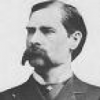
New At Justwrite: Platinum Inks And Maki-E Fountain Pens
JustWrite Pen Company posted a topic in The Mall
Just arrived at JustWrite Platinum Maki-e fountain pens, Platinum ink cartridges and Platinum Mix Free bottled ink. As far as I know this is the first time these pens have been made available in Australia and I'm very pleased to be able to offer them at prices almost comparable to the US. $AUD260 (Approximately $USD200.00) $AUD2.95 (Approximately $USD2.06) Platinum Mix free 60ml bottled ink $AUD27.00. Approximately $USD20.00 -
Sailor “Summer under the Stars” is the last and final pen that makes the “Four Seasons under the Stars” limited edition complete. Discover fireflies, a weeping-willow, waterlilies and a refreshing waterfall. Enjoy this piece of art by the hand of master Ikki Moroiki. Limited to 28pcs only. http://www.sakurafountainpengallery.com/en/fpngallery/gallery-detail/summer-under-the-stars
-
- sailor limited edition
- summer under the stars
- (and 2 more)
-

Maki-E Pens For Showcase Only Or Usable As Every Day Writer?
Nyanzilla posted a topic in Japan - Asia
I really like the design of the various maki-e pens. And I've been thinking of purchasing one for a long time. But as they are quite expensive I'm worried a bit about their sturdiness. Will that painting and urushi laqueur wear when the pen is used for everyday writing? -
Hi Guys, I'd like to start playing around with some "home-made maki-e", i.e., experimenting with shellac lacquer and some metal dust to see if I can get some basic maki-e style patterns. Problem is, I have no idea where to get metal powder. A google search gives only providers of metal powders for industries. It's especially hard to find reliable sites that sell gold dust. But I'd like to experiment with silver, copper and bronze dust as well. Any ideas? thanks, Fabio
-
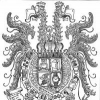
Pilot "cheap" Maki-E: What Amount Of Manual Work Is In There?
TassoBarbasso posted a topic in Japan - Asia
Hi Guys, I've recently bought a Pilot with narcissus decoration in hiramaki-e (One of these) and I find it to be very beautiful. I'm aware that there's a debate as to whether hiramaki-e is a "real" maki-e (whatever that may mean), or just a cheap form. What I would like to know is, what are exactly the manual steps involved in the making of these Pilot pens? My understanding (based on this article from the Encyclopaedia Britannica) is that it's actually a mostly manual work: "The pattern is first outlined on a sheet of paper with brush and ink. It is then traced on the reverse side of the paper with a mixture of heated wet lacquer and (usually red) pigment. The artist transfers the pattern directly to the desired surface by rubbing with the fingertips, a process called okime." Frankly speaking, to me this looks like a purely manual work, not something "industrial", as I sometimes read online. If the procedure followed by Pilot was exactly this, for me this would be more than enough to consider this as a little piece of art, even if it's not as sophisticated as other maki-e tecniques. But I have my doubts that Pilot actually follows this procedure. Hiramaki-e implies manual drawing, then transferred on the pen body, but the pen I have has really neat and precise lines, which I don't believe can be achieved with manual drawing. Any ideas? best, Fabio -
Hi, I would like to ask you for advice. I have just bought a platinum modern maki-e makie crane fountain pen from ebay and I would like to know how I can make sure that the pen is authentic. The pen is a gift for my girlfriend and I want to be sure that it is genuine. Best wishes, Henry
-
Sailor Koshyu (Kou-Shu) Shitsugei Series Hirame With Cobra Nib
katanankes posted a topic in Fountain Pen Reviews
Hi everyone! I would like to contribute with a review. As I was taking pictures of the pen that I reviewed I realized that taking a good picture requires skills and possibly means... apparently I lack both. I am reluctant to post this review, but I welcome feedback on how to improve. I decided to review this unusual Sailor pen because I did not find any past review on FPN and other online spaces. Also, the pen comes with a Cobra Nib, that is quite an unusual nib in the Sailor line up. The pen is part of a maki-e collection commissioned by Sailor to urushi artist Koushu Nishihara that has created five designs using urushi lacquering methods in combination with a variety of of maki-e and Negoro Nuri techniques. Depending on the source, the series is called Koshyu or Kou-shu or even Koushuu (so if you google it, try alternative spellings). My model is called Hirame and consists of several layers or urushi mixed with gold powder. The artist's signature is present. The main reason that I ended up with this pen is that I wanted the Sailor Cobra Nib to enrich my Sailor nib collection and this is one of the few Sailor models on which this elusive nib is available. Let's start with the presentation box: This is a pretty much standard presentation box for Sailor high end pens (well, King of Pen series enjoys a much more impressive box). The wooden box comes with a "pen kimono" that is nice, a piece of polishing cloth, a couple of cartridges, a converter, instructions and a leaflet describing the Cobra nib. I would have expected a more distinctive presentation with a bottle of ink, but what I got is not a problem, I bought a pen and not a box. Let's now describe with more details the pen. Now things get more interesting. The pen is based on an oversize version of the well known Profit 1911 (large). It is a huge pen! A comparison with a Profit 1911 Large can put things into perspective: If the Profit 1911 is a large pen at 14 cm (5.5 inches), this en-longed model comes close to 16 cm (6.3 inches). The pen is built with a matte black material and only the central body is covered in urushi. The urushi gives the pen some extra millimeters in the diameter of the central body. All other details mirror the standard design of the Profit 1911. As you might expect, this pen is a bit heavier than the Profit 1911, around 25 grams as opposed to 21.5 grams of the large Profit model. While the idea that the urushi/maki-e decoration is limited to just one section of the pen might not be so appealing, it has some unquestionable advantages. First, the pen can be posted without prejudice to the urushi (well, not that you really need to post it!). Second, and most important, the nib section can be unscrewed and replaced... The pen is a standard converter/cartridge design as most Sailor pens. What is particularly interesting is that the nib section is compatible with the Sailor Profit 1911 Large nib section. They are interchangeable! This means that if you own other Profit pens (I tested this only on the large model) you can play with the nib section and move nibs across your collection. Personally it is exactly what I did. While the Cobra Nib is great, it is impractical for daily use. In the picture below you can see the swap between the Cobra nib and another specialty nib (Emperor) coming from my 1911: I was unable to take usable close-ups of the nib. However, a fellow FPN member took some gorgeous close-ups of the Cobra Nib (and the King Eagle one) and posted them here. It is worth taking a look. The name is a perfect reflection of the design of the nib that does look like a cobra head. It is an incredibly wet nib capable of huge strokes. Honesty, I do not see anyone writing with a Cobra Nib on a daily basis, even signatures could be excessive with this kind of super broad strokes. Admittedly it is a very special nib, a small work of art per se. Here a fountain pen enthusiast shows how the nib performs and can provide a bit of line variation. A final note on price and availability. I do not know the exact issue date of these pens, but they are quite recent. Looking around on line you can find the basic model with a Togi nib (the entry level in Sailor family of specialty nibs) for 670-800 usd. It is not clear to me if the on line stores advertising them have the pens ready to ship or have to special order them to Sailor. They are sometimes advertised as limited editions, but they are not: there is no limitation number and nothing indicating a limited run. However, given the price tag, I would not imagine too many of them out there. The pen with the Cobra Nib of course costs a lot more, close to 2k. Final evaluation. With 20/20 hindsight this was not a very smart purchase. In the same price range, there are lot of very attractive urushi pens that can make it as a daily writer. However, I am relieved by the fact that I can easily swap nibs between this model and other Sailor pens I own. It is a small consolation, but at least I can use it and I do not have to relegate it in a drawer. The oversize pen is very well balanced and with my unusual grip actually it works perfect, like a glove. This was kind of a discovery for me. I really like slim long pens now and I hope soon to be able to get a Nakaya long. I hope that these notes (and lousy pictures) can be useful for other pen enthusiasts that are curious about this Sailor series or might consider a purchase in the future. Mattia -
Hello Everyone! We had a very nice Exhibition of Pelikan Fountain Pens at our store, and I though it would be very nice to share it with you. We had historical pieces brought directly from the Museum of Hannover in Germany and also a Personal Collection of Pelikan Maki-e, which was lent by a very nice collector! If you would like to see pictures of the Exhibition and the Pelikan Maki-e just click here: Pelikan Exhibition at Iguana Sell Pelikan Maki-e Collection Hope you like it! Have a nice day! Pilar Iguana Sell
-
Does anybody know where the Japanese Urushi Lacquer (seen on pens that have maki-e patterns, or most notably a Nakaya) can be purchased? Or how about methods of making it? I was thinking about taking a Noodler's Nib Creeper and making it into a Nakaya type pen. The clip is easily removed, to get that clean clipless look, and the entire pen can be dissasembled so it should be easy to cover it in the lacquer without hindering mechanical action. Is this even a viable idea? I just really like the look of an Urushi pen, and wanted something that isn't going to cost an arm and a leg (until I proverbially grow some extra limbs). What about color? Will the underlying color show through? I was thinking about buying a red or a black Nib Creeper so the undercolor is nicely matched. Basically I want to go from this: http://www.gouletpens.com/v/vspfiles/photos/N17004-2T.jpg to this: http://rudiphoto.net/img/s3/v39/p967942023.jpg I know my results will vary vastly, but I think it's worth a try to see how it goes. Any input is very much appreciated.
-
For a limited time, get 20% off all Platinum products! Everything is included, from the great #3776 fountain pens to the bargain Platinum Preppy. Explore our complete range of Platinum products here: http://www.cultpens.com/c/q/brands/platinum We're also offering the same discount on all Diplomat products (excluding the Spacetec range!). This includes the newly arrived - to us at least - Aero and Excellence A Plus ranges. You can view our Diplomat range here: http://www.cultpens.com/c/q/brands/diplomat
-
Greetings everyone! Pelikan has launched a new model of the collection Maki-e, and we are very glad to share it with all of you. The Japanese artist Shozo Nakamura painted this fountain pen and we can see how well he captured the essence of the painting he was inspired in (”The great wave of Kanagawa” by Hokusai Katsushika), with the glittering water of the curling wave on the barrel. It is made of tiny pieces of mother-of-pearl and egg shell, and to complete the seaside feeling, the cap is decorated with two Japanese traditional kites and plover birds that swoop over the waves. This is a limited edition of 88 fountain pens of 18 carat bi-color gold nibs. Take a look and contact us if you like it!
- 6 replies
-
- pelikan
- fountain pen
-
(and 4 more)
Tagged with:
-
Despite I know is not a fountain pen (technically, is a rollerball pen) I wanted to share my last piece of maki-e over a pen. The design is inspired on my trips to Asia.Starting by clouds with rain-drops falling under a dark night sky, the pen is dominated by a Pagoda-like decoration inspired in the Ayutthaya and Angkor Period.The rest of the pen is also decorated with rice fields and pine-trees.Finally, the end of barrel and the metallic rollerball cap are lightly sprinkled with golden powder to resemble both the stars and the reflection of them over water.I hope you like it.
- 24 replies
-
- montblanc
- starwalker
- (and 4 more)
-
Hi, Some of you know me by name, some of you know me by face. My name is Matt, I work at Ito-ya in Ginza. Everyone on this forum has been extremely helpful and insightful over the last few years. I am not promoting anything for my company, but I would like to ask for your opinions and advice on an event that I am trying to plan for our main store in Tokyo. During the summer, on weekends, I would like to hold a Maki-e class in English for the many foreign customers that visit our store. In the past, we have held Maki-E classes for our Japanese customers, but Japanese people do not seem to be as enamored by the Maki-e technique as their foreign counter parts. I know that the people that subscribe to this section of FPN love Japanese pens and there seems to be a great deal of interest in the art of Maki-e. My plans for the class would be to give a 30-45min class, in English, about the different techniques used in the Maki-e process explaining why one pen may cost about $50 but another can cost upwards of $10,000. I also plan on covering the history of the process and its traditional uses other than the fountain pens that we are all familiar with. If there is only a class where we hand out a small brochure and or leaflet, we will be able to hold the class for free. However, if only being able to hand out leaflets does not draw people to the class we are thinking about doing an event where the customers will be able to make their own 'maki-e' souvenir. This, however, would end up causing the class to cost about 3000JPY. So, basically, I want to ask you lovely people and pen lovers, 'What would you like to see in a Maki-e class?' How important would making your own Maki-e souvenir be? Would just learning about the process for 30-40min satisfy your lust for knowledge, just wet you appetite or be mind numbingly long and tedious? Would including a breif history of Japanese fountain pens in general make the topic less dull and more interesting? Also, if you were in Tokyo this summer, is this something that you would like to learn more about? Is this an event that would interest you? I personally love Maki-e and want to share it with the world. I thank you all in advance for any opinions/advice that you can give me. Sincerely, Matt
-
I bought my Namiki Maki-e Pine Tree Bonsai fountain pen from Classic Fountain Pens. It was among their "previously owned" pens, and I snatched it up after being very disappointed by the Pilot Falcon Resin I had bought a few weeks before. This Namiki came with a medium 14K nib that I had reground into an italic stub. Obviously, a Japanese medium isn't going to turn into a big italic with lots of line variation, but I definitely love the line I'm getting. My writing always benefits from an italic nib no matter what the size. The pen itself is gorgeous, with a gleaming black surface adorned with the Maki-e decoration. You can feel the Maki-e with your fingers, and the pine tree bonsai motif is beautiful yet subtle. The pen is comfortable in the hand and just the right weight for me (14mm x 142mm; 18 grams). The Namiki comes with the Pilot Con-70 converter which holds a good amount of ink (1 ml). I was disappointed with the tiny amount the Pilot Falcon held. With the Namiki converter, you can pump a sufficient amount of ink into the pen to last for days. And it is a pump converter, which I discovered only after several futile attempts at twisting the knob! I had to do a Google search and watch a video to learn that I was doing it wrong. Sigh. I have nothing negative to say about this pen. It writes beautifully thanks to the nib work done by Classic Pens. It sits perfectly in the hand and is neither too heavy nor too light. It exudes quality (unlike the Falcon)—it doesn't feel plasticky at all, but substantial. And it is gorgeous. It is on the costly side (you can find this particular design on eBay, but Namiki apparently no longer carries it). I personally never buy anything from eBay, and I probably paid more because I bought it from Classic Fountain Pens. But I trust them and know that I'm getting the real deal. I love my German Pelikans, but Japanese pens (Nakaya, Namiki, Platinum) are quickly out-numbering all my other fountain pens. Something about the quality and aesthetic draws me to these pens. Fountain Pen Network Rating System: Appearance and Design: 10 Construction and Quality: 10 Weight and Dimensions: 10 Nib and Performance: 10 (I don't know what the nib would be like right out of the box since I had my nib reground). Filling System and Maintenance: 10 (Once I figured it out!) Cost and Value: 10 Conclusion: 60/60
-
Danitrio Kaguya-hime of Taketori Monogatari http://farm4.staticflickr.com/3763/9603415961_7470681eea_b.jpg Kaguya-hime is depicted with her back facing us. She is wearing a "hagoromo", or "feather robe", through which her long tresses flow as she ascends to the moon, depicted here in raden surrounded by gold dust. Introduction The subject of today's review: one of my maki-e pens, the Danitrio Kaguya-hime of Taketori Monogatari, or Tale of the Bamboo Cutter. Back in 2009 I was fortunate to score the last unsold piece (#20 out of 30 pieces made in this size). Kevin Cheng (winedoc) was instrumental in helping me order this pen direct from the manufacturer. Thanks, Kevin! Two versions of this maki-e pen exist, a testament to the enduring popularity of this maki-e design and the story behind it: the one shown here, in the Takumi (I believe) size - similar in size to the Montblanc 149; and the Yokozuna size, a huge monster of a pen equipped with a 24-karat gold nib. Both versions are made by the artist Koichiro Okazaki (signature: Kogaku), one of the more prolific artists within the Danitrio stable. The Kaguya-hime story from the Danitrio website: It is considered the oldest tale in Japan written in the Heian period (794-1185). One day, an old bamboo cutter went into a bamboo clump to collect bamboo, and found a glittering bamboo and cut it. There was a beautiful girl from the bamboo and the old man gave the girl a name "Kaguya-hime" and brought her up in his home. The girl was so beautiful that five young nobles wanted her to marry them, but she refused all of them by giving them knotty questions impossible to answer. She even did not accept the emperor's invitation and finally flew to the harvest moon in the eve on August 15th (August 15th in lunar calendar is Mid-autumn Day in Asia). More details about this story can be found here: http://en.wikipedia.org/wiki/The_Tale_of_the_Bamboo_Cutter. Writing Experience and pen construction My pen came originally equipped with a flexible stub nib. For the longest time I couldn't get this flexible stub nib to work for me. It was hard-starting, and would "click" as I write. I sent it back to Kevin to have the nib exchanged to a firm stub nib. This stub nib was much better, but only after I sent it to John Mottishaw (twice!) would the pen write satisfactorily. Even now, this nib will baulk before putting ink to paper if I don't use it everyday. I have heard that the other Danitrio nib sizes are much less temperamental, so one of these days I might just ask Kevin to help me exchange the nib for a fine size. Apart from the nib, the overall quality of pen construction is beyond reproach. The most traditional of fountain pen materials - ebonite - is used for the entire pen body and cap, and the lathe work is excellent. Everything fits together perfectly, and the barrel threads are cut so that the maki-e design lines up every time the cap is screwed on. Maki-e design I must confess that I bought this pen after being sorely tempted by the luscious photographs that Kevin posted of the same pen on this forum. He's quite the greatest enabler...! Anyway, onto the photos I took of this pen. Maki-e is notoriously difficult to photograph, but hopefully my photographs help to bring out some of the beauty of this pen. Just like Kevin, I hope that one day Princess Kaguya will turn around to show us her beauty, but at the same time I believe it's better to leave some things to the imagination. What do you think? http://farm4.staticflickr.com/3726/9603416019_7b55e94c06_b.jpg Note the generous maki-e application on this pen. Even the section and pen clip are sprinkled with gold dust. My pen is equipped with a Danitrio firm stub nib in the "flaming" pattern. http://farm8.staticflickr.com/7438/9606650940_c87cf3e248_b.jpg It's amazing how such a vast maki-e design can be achieved on the small surface area of a pen. http://farm6.staticflickr.com/5530/9603424015_61a771b2d8_b.jpg And a close-up of the back of Princess Kaguya. I love the exquisite maki-e details of her robes!
-
Hello ! I have one Sailor wood maki-e that has a fine writing but, strangely, the nib is not marked fine or extra fine (I have seen another sailor wood maki-e where the nib is marked M..in other online fotos I have seen them marked but with the number 2. I would appreciate some help from more experienced collectors/users in identifying if this nib is fine or extra fine ? Or what is the meaning of the 2 ? Thanks in advance for your help Christian



